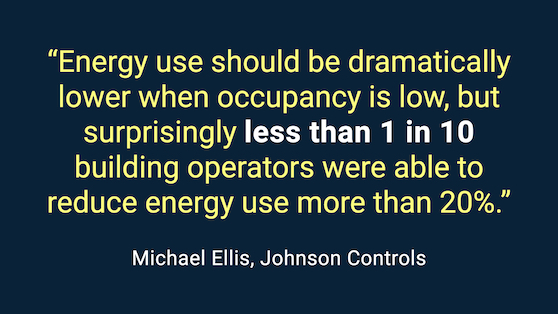
Commercial
Features
News
Despite lower occupancy, building owners struggle to reduce operating costs
March 15, 2021 By Anthony Capkun

March 15, 2021 – According to surveys of 800+ building decision-makers, Johnson Controls reports that few customers were able to reduce building operating costs, despite lower occupancy due to the pandemic.
“Energy use should be dramatically lower when occupancy is low, but surprisingly less than 1 in 10 building operators were able to reduce energy use more than 20%,” said Michael Ellis, Johnson Controls.
“Building owners are struggling to balance urgent and conflicting priorities between employee health and wellness with critically needed cost savings, increased revenue and sustainability targets,” added Ellis.
The survey of facilities operators showed a range of specific investment priorities, which Johnson Controls has categorized as: Healthy People, Healthy Places, Healthy Planet.
Healthy people
Johnson Controls’ surveys show an increase in investments toward wellness, clean air and “peace of mind”, with 80% of respondents stating that protecting the health & safety of building occupants during the pandemic and afterward is “Very or Extremely Important”.
Some of the factors involved in protecting occupants include temperature control, disinfection, ventilation and air filtration, enhanced through intelligent sensors and control software.
The pandemic has increased the potential benefit of these technologies, as well as for contactless access and contact tracing. These capabilities can help increase overall building security through enhanced tracking of building guest and occupant access, flow and location.
Healthy places
Finding cost savings and making fast and informed decisions, supported by data, is a critical part of facility operations, adds Johnson Controls. Pointing to its studies, 80% of facility executives stated that increasing flexibility to quickly respond to emergencies is a top driver for investment in technologies such as flexible facility monitoring and healthy air strategies.
Space optimization, capital planning and increasing the uptime and life of assets “all support operational performance, and lead to cost savings and increased revenue opportunities for building operators,” added Johnson Controls.
Healthy planet
Improvements in energy efficiency, renewable energy and smart building technology are becoming more critical each year, adds the company. In the studies, 76% of facility executives stated that energy cost savings are a top driver for investment.
The studies also revealed that 57% of organizations plan to achieve net zero carbon or positive energy status in at least one facility in the next 10 years.
CLICK HERE to download Johnson Controls’ Vertical Pulse Surveys.
Print this page